Electrochemical Corrosion Behavior of Passivated Precipitation Hardening Stainless Steels for Aerospace Applications
Abstract
1. Introduction
2. Materials and Methods
2.1. Materials
2.2. Passivation Treatment
- (a)
- Pretreatment: degreased and pickled stainless steel in a 50 wt.% HCl solution (analytical grade reagents (J.T. Baker, Nuevo León, México) for 5 s at 25 °C, and rinsed in distilled water.
- (b)
- (c)
- Final Stage: the specimens were rinsed in distilled water (analytical grade reagents (J.T. Baker)).
2.3. Corrosion Tests
3. Results and Discussion
3.1. OM Microstructural Analysis
3.2. Potentiodynamic Polarization
4. Conclusions
- OM characterization indicated that the martensitic PHSS presented a microstructure with a martensitic (α′) phase and a semi-austenitic PHSS containing a microstructure of austenite (γ) and delta (δ) ferrite phases, respectively. Based on the values obtained from PREN, the AM 350 (semi-austenitic) (29.80) presented a higher corrosion resistance than the martensitic 15-5 PH (23.5), 17-4 PH (17.5), and CUSTOM 450 (20.9).
- Potentiodynamic polarization results allowed us to determine the corrosion kinetic behavior of PHSS passivated samples immersed in H2SO4 and NaCl solutions and passivity in the anodic branch.
- The current density levels in NaCl solution were between 10−4 and 10−5 mA/cm2, while those of H2SO4 were recorded around 10−2 and 10−3 mA/cm2.
- Using the citric acid bath as a substitute for nitric acid in the passivation process generates a system in which the electrochemical behavior is similar, mixed by activation, where the anodic branch presents a series of events such as pseudo-passivation and/or passivation–transpassivation–secondary passivation.
- PHSS passivated in nitric acid and immersed in sodium chloride have higher pitting potentials than samples passivated in citric acid.
- The citric acid passivation treatment on PHSS could be a green alternative to the currently employed nitric acid passivation treatment because it is not toxic and is friendly to the environment.
- Based on the results obtained from the corrosion behavior of passivated PHSS, it is considered that future work may use electrochemical impedance spectroscopy to analyze and complement the corrosion mechanism and characterize the oxides through the XPS technique.
Author Contributions
Funding
Acknowledgments
Conflicts of Interest
References
- Mouritz, P.A. Introduction to Aerospace Materials; Woodhead Publishing: Cambridge, UK, 2012. [Google Scholar]
- Gloria, A.; Montanari, R.; Richetta, M.; Varone, A. Alloys for aeronautic applications: State of the art and perspectives. Metals 2019, 9, 662. [Google Scholar] [CrossRef]
- Martinez, B.; Tiburcio, C.G.; Bastidas, D.; Lara-Banda, M.; Samaniego, O.; Calderon, F.A. Electrochemical Evaluation of 15-5PH Stainless Steel Passivated in Citric Acid. ECS Trans. 2022, 106, 223. [Google Scholar] [CrossRef]
- Lopes, J.C. Material selection for aeronautical structural application. Sci. Technol. Adv. Mater. 2008, 20, 78–82. [Google Scholar]
- Lo, K.H.; Shek, C.H.; Lai, J.K.L. Recent developments in stainless steels. Mater. Sci. Eng. R. 2009, 65, 39–104. [Google Scholar] [CrossRef]
- Lara Banda, M.; Gaona-Tiburcio, C.; Zambrano-Robledo, P.; Cabral, M.J.A.; Estupinan, F.; Baltazar-Zamora, M.A.; Almeraya-Calderon, F. Corrosion Behaviour of 304 Austenitic, 15-5PH and 17-4PH Passive Stainless Steels in acid solutions. Int. J. Electrochem. Sci. 2018, 13, 10314–10324. [Google Scholar] [CrossRef]
- Gialanella, S.; Malandruccolo, A. Aerospace Alloys; Topics in Mining, Metallurgy and Materials Engineering; Bergmann, C.P., Ed.; Springer: Cham, Switzerland, 2020; ISSN 2364-3307. [Google Scholar] [CrossRef]
- Cobb, H.M. The History of Stainless Steel; ASM International: Cleveland, OH, USA, 2010; pp. 189–192. [Google Scholar]
- Ha, H.Y.; Jang, J.H.; Lee, T.H.; Won, C.; Lee, C.H.; Moon, J.; Lee, C.G. Investigation of the localized corrosion and passive behavior of type 304 stainless steels with 0.2–1.8 wt% B. Materials 2018, 11, 2097. [Google Scholar] [CrossRef]
- Schmuki, P. From bacon to barriers: A review on the passivity of metal and alloys. J. Solid State Electr. 2002, 6, 145–164. [Google Scholar] [CrossRef]
- Dong, H.; Esfandiari, M.; Li, X.Y. On the microstructure and phase identification of plasma nitrided 17-4PH precipitation hardening stainless steel. Surf. Coat. Technol. 2008, 202, 2969–2975. [Google Scholar] [CrossRef]
- Hsiao, C.N.; Chiou, C.S.; Yang, J.R. Aging reactions in a 17-4 PH stainless steel. Mater. Chem. Phys. 2002, 74, 134–142. [Google Scholar] [CrossRef]
- Samaniego-Gámez, O.; Almeraya-Calderón, F.; Chacón-Nava, J.; Maldonado-Bandala, E.; Nieves-Mendoza, D.; Flores-De los Rios, J.P.; Gaona-Tiburcio, C. Corrosion Behavior of Passivated CUSTOM450 and AM350 Stainless Steels for Aeronautical Applications. Metals 2022, 12, 666. [Google Scholar] [CrossRef]
- Gladman, T. Precipitation hardening in metals. Mater. Sci. Technol. 1999, 15, 30–36. [Google Scholar] [CrossRef]
- Farrar, J. The Alloy Tree—A Guide to Low-Alloy Steels, Stainless Steels and Nickel-base Alloys; Woodhead Publishing Limited and CRC Press: Sawston, UK, 2004. [Google Scholar]
- Gaydos, S.P. Passivation of aerospace stainless parts with citric acid solutions. Plat. Surf. Finish. 2003, 90, 20–25. [Google Scholar]
- ASTM A967-17; Standard Specification for Chemical Passivation Treatments for Stainless Steel Parts. ASTM International: West Conshohocken, PA, USA, 1999.
- Shibata, T. Stochastic studies of passivity breakdown. Corros. Sci. 1990, 31, 413–423. [Google Scholar] [CrossRef]
- Ashassi-Sorkhabi, H.; Seifzadeh, D.; Raghibi-Boroujeni, M. Analysis of electrochemical noise data in both time and frequency domains to evaluate the effect of ZnO nanopowder addition on the corrosion protection performance of epoxy coatings. Arab. J. Chem. 2016, 9, S1320–S1327. [Google Scholar] [CrossRef]
- El-Taib Heakal, F.; Ameer, M.A.; El-Aziz, A.M.; Fekry, A.M. Electrochemical behavior of Mo-containing austenitic stainless steel in buffer solutions. Mater. Werkstofftech. 2004, 35, 407–413. [Google Scholar] [CrossRef]
- El-Taib Heakal, F.; Ghoneim, A.; Fekry, A. Stability of spontaneous passive films on high strength Mo-containing stainless steels in aqueous solutions. J. Appl. Electrochem. 2007, 37, 405–413. [Google Scholar] [CrossRef]
- Ameer, M.A.; Fekry, A.M.; El-TaibHeakal, F. Electrochemical behaviour of passive films on molybdenum-containing austenitic stainless steels in aqueous solutions. Electrochim. Acta 2004, 50, 43–49. [Google Scholar] [CrossRef]
- Lara-Banda, M.; Gaona-Tiburcio, C.; Zambrano-Robledo, P.; Delgado-E, M.; Cabral-Miramontes, J.A.; Nieves-Mendoza, D.; Maldonado-Bandala, E.; Estupiñan-López, F.; Chacón-Nava, J.G.; Almeraya-Calderón, F. Alternative to nitric acid passivation of 15-5 and 17-4PH stainless steel using electrochemical techniques. Materials 2020, 13, 2836. [Google Scholar] [CrossRef]
- Bragaglia, M.; Cherubini, V.; Cacciotti, I.; Rinaldi, M.; Mori, S.; Soltani, P.; Nanni, F.; Kaciulis, S.; Montesperelli, G. Citric Acid Aerospace Stainless Steel Passivation: A Green Approach. In Proceedings of the CEAS Aerospace Europe Conference 2015, Delft, The Netherlands, 7–11 September 2015. [Google Scholar]
- Marcelin, S.; Pébèrea, N.; Régnierb, S. Electrochemical characterisation of a martensitic stainless steel in a neutral chloride solution. Electrochim. Acta 2013, 87, 32–40. [Google Scholar] [CrossRef]
- Mollapour, Y.; Poursaeidi, E. Experimental and numerical analysis of Pitting Corrosion in CUSTOM 450 Stainless Steel. Eng. Fail. Anal. 2021, 128, 105589. [Google Scholar] [CrossRef]
- Lin, C.K.; Chu, C.C. Mean stress effects on low-cycle fatigue for a precipitation-hardening martensitic stainless steel in different tempers. Fatigue Fract. Eng. Mater. Struct. 2000, 23, 545–553. [Google Scholar] [CrossRef]
- Almeraya-Calderón, F.; Samaniego-Gámez, O.; Maldonado-Bandala, E.; Nieves-Mendoza, D.; Olguín-Coca, J.; Jáquez-Muñoz, J.M.; Cabral-Miramontes, J.; Flores-De los Rios, J.P.; Bautista-Margulis, R.G.; Gaona-Tiburcio, C. Corrosion Behavior of Passivated Martensitic and Semi-Austenitic Precipitation Hardening Stainless Steel. Metals 2022, 12, 1033. [Google Scholar] [CrossRef]
- Gaona Tiburcio, C.; Samaniego-Gámez, O.; Jáquez-Muñoz, J.; Baltazar-Zamora, M.A.; Landa-Ruiz, L.; Lira-Martínez, A.; Flores-De los Rios, J.P.; Cabral-Miramontes, J.; Estupinán-López, F.; Almeraya-Calderon, F. Frequency-Time Domain Analysis of Electrochemical Noise of Passivated AM350 Stainless Steel for Aeronautical Applications. Int. J. Electrochem. Sci. 2022, 17, 220950. [Google Scholar] [CrossRef]
- Custom 450® Stainless Steel. Available online: https://www.ulbrich.com/uploads/data-sheets/Custom-450-Stainless-Steel-Wire-UNS-S45000.pdf (accessed on 30 April 2022).
- 15-5PH Stainless|AMS5659. (s. f.). Available online: https://www.smithsadvanced.com/15-5ph-stainless (accessed on 7 November 2022).
- CIVMATS CO., Ltd. 17-4PH Stainless Steel-Introduction, Applications, Data Sheet. civmats.com. Available online: https://www.civmats.com/grades/GRADES-17-4PH.HTML (accessed on 7 November 2022).
- AM 350 Technical Data. Available online: https://www.hightempmetals.com/techdata/hitempAM350data.php (accessed on 29 September 2022).
- ASTM A380-17; Standard Practice for Cleaning, Descaling and Passivation of Stainless-Steel Parts, Equipment, and Systems. ASTM International: West Conshohocken, PA, USA, 1999.
- ASTM E3-95; Standard Practice for Preparation of Metallographic Specimens. ASTM International: West Conshohocken, PA, USA, 1995.
- SAE AMS 2700F; Passivation of Corrosion Resistant Steels. Aerospace Material Specification. SAE International: Warrendale, PA, USA, 2018.
- ASTM G5-11; Standard Reference Test Method for Making Potentiostatic and Potentiodynamic Anodic Polarization Measurements. ASTM International: West Conshohocken, PA, USA, 2011.
- Jaquez-Muñoz, J.; Gaona-Tiburcio, C.; Lira-Martinez, A.; Zambrano-Robledo, P.; Maldonado-Bandala, E.; Samaniego-Gamez, O.; Nieves-Mendoza, D.; Olguin-Coca, J.; Estupiñan-Lopez, F.; Almeraya-Calderon, F. Susceptibility to pitting corrosion of Ti-CP2, Ti-6Al-2Sn-4Zr-2Mo, and Ti-6Al-4V alloys for aeronautical applications. Metals 2021, 11, 1002. [Google Scholar] [CrossRef]
- Montoya-Rangel, M.; de Garza-Montes, O.N.; Gaona-Tiburcio, C.; Colás, R.; Cabral-Miramontes, J.; Nieves-Mendoza, D.; Maldonado-Bandala, E.; Chacón-Nava, J.; Almeraya-Calderón, F. Electrochemical Noise Measurements of Advanced High-Strength Steels in Different Solutions. Metals 2020, 10, 1232. [Google Scholar] [CrossRef]
- Cabral-Miramontes, J.A.; Bastidas, M.D.; Baltazar, M.A.; Zambrano-Robledo, P.; Bastidas, J.M.; Almeraya-Calderón, F.; Gaona-Tiburcio, C. Corrosion behavior of Zn-TiO2 and Zn-ZnO Electrodeposited Coatings in 3.5% NaCl solution. Int. J. Electrochem. Sci. 2019, 14, 4226–4239. [Google Scholar] [CrossRef]
- Abedi, H.R.; Hanzaki, A.Z.; Haghdadi, N.; Hodgson, P.D. Substructure induced twinning in low density steel. Scr. Mater. 2017, 128, 69–73. [Google Scholar] [CrossRef]
- Gupta, A.; Bhargava, A.K.; Tewari, R.; Tiwari, A.N. TEM studies of boron-modified 17Cr-7Ni precipitation-hardenable stainless steel via rapid solidification route. Metal. Mater. Trans. A 2013, 44, 4248–4256. [Google Scholar] [CrossRef]
- Xu, X.L.; Yu, Z.W. Metallurgical analysis on a bending failed pump-shaft made of 17-7PH precipitation-hardening stainless steel. J. Mater. Process. Technol. 2008, 198, 254–259. [Google Scholar] [CrossRef]
- Ramirez-Arteaga, A.M.; Gonzalez-Rodriguez, J.G.; Campillo, B.; Gaona-Tiburcio, C.; Dominguez-Patiño, G.; Leduc Lezama, L.; Chacon-Nava, J.G.; Neri-Flores, M.A.; Martinez-Villafañe, A. An electrochemical study of the corrosion behavior of a dual phase steel in 0.5 m H2SO4. Int. J. Electrochem. Sci. 2010, 5, 1786–1798. [Google Scholar]
- The British Stainless Steel Association 2022. Available online: https://bssa.org.uk/bssa_articles/calculation-of-pren/ (accessed on 2 June 2022).
- Schweitzer, P. Fundamentals of Metallic Corrosion: Atmospheric and Media Corrosion of Metals; CRC Press Taylor & Francis Group: Boca Raton, FL, USA, 2007; ISBN 10:0-8493-8243-2. [Google Scholar]
- Olsson, C.-O.A. Wet Corrosion of Stainless Steels and Other Chromium-Bearing Alloys. In Encyclopedia of Interfacial Chemistry; Surface Science and Electrochemistry; Elsevier: Bonn, Germany, 2018; pp. 535–542. [Google Scholar] [CrossRef]
- Tafel, J. Über die Polarisation bei kathodischer Wasserstoffentwicklung. Z. Für Phys. Chem. 1905, 50, 641–712. [Google Scholar] [CrossRef]
- Butler, J.A.V. Studies in heterogeneous equilibria. Part II.—The kinetic interpretation on the Nernst theory of electromotive force. Trans. Faraday Soc. 1924, 19, 729–733. [Google Scholar] [CrossRef]
- Bojinov, M.; Fabricius, G.; Laitinen, T.; Saario, T. The mechanism of the transpassive dissolution of chromium in acidic sulfate solutions. J. Electrochem. Soc. 1998, 145, 2043–2050. [Google Scholar] [CrossRef]
- Tian, H.; Sun, F.; Chu, F.; Wang, L.; Wang, X.; Cui, Z. Passivation behavior and surface chemistry of 316 SS in the environment containing Cl− and NH4+. J. Electroanal. Chem. 2021, 886, 115138. [Google Scholar] [CrossRef]
- Zhu, Z.; Zhang, Q.; Liu, P.; Zhang, J.; Cao, F. Quasi-simultaneous electrochemical/chemical imaging of local Fe2+ and pH distributions on 316 L stainless steel surface. J. Electroanal. Chem. 2020, 871, 114107. [Google Scholar] [CrossRef]
- Duan, Z.; Man, C.; Dong, C.; Cui, Z.; Kong, D.; Wang, L.; Wang, X. Pitting behavior of SLM 316L stainless steel exposed to chloride environments with different aggressiveness: Pitting mechanism induced by gas pores. Corros. Sci. 2020, 167, 108520. [Google Scholar] [CrossRef]
- Noh, L.S.; Laycock, N.J.; Gao, W.; Wells, D.B. Effects of nitric acid passivation on the pitting resistance of 316 stainless steel. Corros. Sci. 2000, 42, 2069–2084. [Google Scholar] [CrossRef]
- Brossia, C.S.; Kelly, R.G. On the role of alloy sulfur in the initiation of crevice corrosion in stainless steel. In Critical Factors in Localized II; Natishan, P.M., Kelly, R.G., Frankel, G.S., Newman, R.C., Eds.; The Electrochemical Society: Pennington, NJ, USA, 1996; Volumes 95–115, pp. 201–217. [Google Scholar]
- Doh, S.J.; Je, J.H.; Kim, J.S.; Kim, K.Y.; Kim, H.S.; Lee, Y.D.; Lee, J.M.; Hwu, Y. Influence of Cr and Mo on the passivation of stainless steel430 (18Cr) and 444 (18Cr–2Mo): In situ XANES study. Nucl. Instrum. Methods B 2003, 199, 211–215. [Google Scholar] [CrossRef]
- Choudhary, S.; Qiu, Y.; Thomas, S.; Birbilis, N. Element-resolved electrochemical analysis of transpassive dissolution and repassivation behavior of the multi-principal element alloy AlTiVCr. Electrochim. Acta 2020, 362, 137104. [Google Scholar] [CrossRef]
- Li, Z.X.; Zhang, L.M.; Udoh, I.I.; Ma, A.L.; Zheng, Y.G. Deformation-induced martensite in 304 stainless steel during cavitation erosion: Effect on passive film stability and the interaction between cavitation erosion and corrosion. Tribol. Int. 2022, 167, 107422. [Google Scholar] [CrossRef]
- Zhang, L.; Qi, L.; Deng, S.; Oguntuase, O.; Deng, T.; Wang, H.; Ojo, A. Analyses of Anodically Formed Passive Film and Corrosion Behavior of Wire-arc Additive Manufactured ATI 718Plus® Superalloy. Addit. Manuf. 2021, 48, 102443. [Google Scholar] [CrossRef]
- Gaona-Tiburcio, C.; Aguilar, L.M.R.; Zambrano-Robledo, P.; Estupiñán-López, F.; Cabral-Miramontes, J.A.; Nieves-Mendoza, D.; Castillo-González, E.; Almeraya-Calderón, F. Electrochemical Noise Analysis of Nickel Based Superalloys in Acid Solutions. Int. J. Electrochem. Sci. 2014, 9, 523–533. [Google Scholar]
- Baltazar, M.A.; Bastidas, D.M.; Santiago, G.; Mendoza, J.M.; Gaona, C.; Bastidas, J.M.; Almeraya, F. Effect of silica fume and fly ash admixtures on the corrosion behavior of AISI 304 embedded in concrete exposed in 3.5% NaCl solution. Materials 2019, 12, 4007. [Google Scholar] [CrossRef] [PubMed]
- Buchanan, A.R.; Stansbury, E.E. 4—Electrochemical Corrosion. In Handbook of Environmental Degradation of Materials, 2nd ed.; Elsevier: Amsterdam, The Netherlands, 2012; pp. 87–125. [Google Scholar] [CrossRef]
- Santiago, G.; Baltazar, M.A.; Galván, R.; López, L.; Zapata, F.; Zambrano, P.; Gaona, C.; Almeraya, F. Electrochemical Evaluation of Reinforcement Concrete Exposed to Soil Type SP Contaminated with Sulphates. Int. J. Electrochem. Sci. 2016, 11, 4850–4864. [Google Scholar] [CrossRef]
- Betova, I.; Bojinov, M.; Laitinen, T.; Mäkelä, K.; Pohjanne, P.; Saario, T. The transpassive dissolution mechanism of highly alloyed stainless steels: I. Experimental results and modelling procedure. Corros. Sci. 2002, 44, 2675–2697. [Google Scholar] [CrossRef]
- Fattah-Alhosseini, A.; Saatchi, A.; Golozar, M.A.; Raeissi, K. The transpassive dissolution mechanism of 316L stainless steel. Electrochim. Acta 2009, 54, 3645–3650. [Google Scholar] [CrossRef]
- Man, C.; Dong, C.; Cui, Z.; Xiao, K.; Yu, Q.; Li, X. A comparative study of primary and secondary passive films formed on AM355 stainless steel in 0.1 M NaOH. Appl. Surf. Sci. 2018, 427, 763–773. [Google Scholar] [CrossRef]
- Bojinov, M.; Betova, I.; Fabricius, G.; Laitinen, T.; Saario, T. The stability of the passive state of iron–chromium alloys in sulphuric acid solution. Corros. Sci. 1999, 41, 1557–1584. [Google Scholar] [CrossRef]
- Núñez-Jaquez, R.E.; Buelna-Rodríguez, J.E.; Barrios-Durstewitz, C.P.; Gaona-Tiburcio, C.; Almeraya-Calderón, F. Corrosion of modified concrete with sugar cane bagasse ash. Int. J. Corros. 2012, 2012, 451864. [Google Scholar] [CrossRef]
- Bojinov, M.; Fabricius, G.; Kinnunen, P.; Laitinen, T.; Mäkelä, K.; Saario, T.; Sundholm, G. The mechanism of transpassive dissolution of Ni–Cr alloys in sulphate solutions. Electrochim. Acta 2000, 45, 2791–2802. [Google Scholar] [CrossRef]
- Huang, J.; Wu, X.; Han, E.H. Electrochemical properties and growth mechanism of passive films on Alloy 690 in high-temperature alkaline environments. Corros. Sci. 2010, 52, 3444–3452. [Google Scholar] [CrossRef]
- Calinski, C.; Strehblow, H.H. ISS depth profiles of the passive layer on Fe/Cr alloys. J. Electrochem. Soc. 1989, 36, 1328–1331. [Google Scholar] [CrossRef]
- Martinez-Villafane, A.; Chacon-Nava, J.G.; Gaona-Tiburcio, C.; Almeraya-Calderon, F.; Dominguez-Patino, G.; Gonzalez-Rodriguez, J.G. Oxidation performance of a Fe–13Cr alloy with additions of rare earth elements. Mater. Sci. Eng. A 2003, 363, 15–19. [Google Scholar] [CrossRef]
- Messinese, E.; Casanova, L.; Paterlini, L.; Capelli, F.; Bolzoni, F.; Ormellese, M.; Brenna, A. A Comprehensive Investigation on the Effects of Surface Finishing on the Resistance of Stainless Steel to Localized Corrosion. Metals 2022, 12, 1751. [Google Scholar] [CrossRef]
- Vodárek, V.; Rožnovská, G.; Kuboň, Z.; Volodarskaja, A.; Palupčíková, R. The Effect of Long-Term Ageing at 475 °C on Microstructure and Properties of a Precipitation Hardening MartensiticStainless Steel. Metals 2022, 12, 1643. [Google Scholar] [CrossRef]
- Ueda, M.; Ikeda, A. Effect of Microstructure and Cr Content in steel on CO2 Corrosion. In Proceedings of the CORROSION 96, Denver, CO, USA, 24–29 March 1996. Paper No. 96013. [Google Scholar]
- Esmaeely, S.N.; Choi, Y.S.; Young, D.; Nesic, S. Effect of calcium on the formation and protectives of iron carbonate layer in CO2 corrosion. Corrosion 2013, 69, 912–920. [Google Scholar] [CrossRef]
- Keddam, M.; Mattos, O.; Takenouti, H. Mechanism of anodic dissolution of iron-chromium alloys investigated by electrode impedances-II. Elaboration of the reaction model. Electrochim. Acta 1986, 31, 1159–1165. [Google Scholar] [CrossRef]
- Gao, K.W.; Yu, F.; Pang, X.L.; Zhang, G.A.; Qiao, L.J.; Chu, W.Y.; Lu, M.X. Mechanical properties of CO2 corrosion product scales and their relationship to corrosion rates. Corros. Sci. 2008, 50, 2796–2803. [Google Scholar] [CrossRef]
- Li, J.; Lin, B.; Zheng, H.; Wang, Y.; Zhang, H.; Zhang, Y.; Nie, Z.; Tang, J. Study on pitting corrosion behavior and semi in-situ pitting corrosion growth model of 304 L SS with elastic stress in NaCl corrosion environment. Corros. Sci. 2023, 211, 110862. [Google Scholar] [CrossRef]
- Tranchida, G.; Clesi, M.; Franco, F.D.; Quarto, F.D.; Santamaria, M. Electronic properties and corrosion resistance of passive films on austenitic and duplex stainless steels. Electrochim. Acta 2018, 273, 412–423. [Google Scholar] [CrossRef]
- Ma, L.; Pascalidou, E.M.; Wiame, F.; Zanna, S.; Maurice, V.; Marcus, P. Passivation mechanisms and pre-oxidation effects on model surfaces of FeCrNi austenitic stainless steel. Corros. Sci. 2020, 167, 108483. [Google Scholar] [CrossRef]
- Cabral Miramontes, J.A.; Barceinas Sánchez, J.D.O.; Almeraya Calderón, F.; Martínez Villafañe, A.; Chacón Nava, J.G. Effect of Boron Additions on Sintering and Densification of a Ferritic Stainless Steel. J. Mater. Eng. Perform. 2010, 19, 880–884. [Google Scholar] [CrossRef]
- Gaona-Tiburcio, C.; Montoya, R.M.; Cabral, M.J.A.; Estupiñan, L.F.; Zambrano, R.P.; Orozco, C.R.; Chacon-Nava, J.G.; Baltazar, Z.M.A.; Almeraya-Calderon, F. Corrosion resistance of multilayer coatings deposited by PVD on inconel 718 using electrochemical impedance spectroscopy technique. Coatings 2020, 10, 521. [Google Scholar] [CrossRef]
- Fattah-alhosseini, A.; Taheri Shoja, S.; Heydari Zebardast, B.; Mohamadian Samim, P. An Electrochemical Impedance Spectroscopic Study of the Passive State on AISI 304 Stainless Steel. Int. J. Electrochem. 2011, 2011, 152143. [Google Scholar] [CrossRef]
- Castro, B.E.; Vilche, R.J. Investigation of passive layers on iron and iron-chromium alloys by electrochemical impedance spectroscopy. Electrochim. Acta 1993, 38, 1567–1572. [Google Scholar] [CrossRef]
- Martínez-Villafañe, A.; Almeraya-Calderón, M.F.; Gaona-Tiburcio, C.; Gonzalez-Rodriguez, J.G.; Porcayo-Calderón, J. High-Temperature Degradation and Protection of Ferritic and Austenitic Steels in Steam Generators. J. Mater. Eng. Perform. 1998, 7, 108–113. [Google Scholar] [CrossRef]
- Lv, J.; Liang, T.; Wang, C.; Dong, L. Comparison of corrosion properties of passive films formed on coarse grained and ultrafine grained AISI 2205 duplex stainless steels. J. Electroanal. Chem. 2015, 757, 263–269. [Google Scholar]
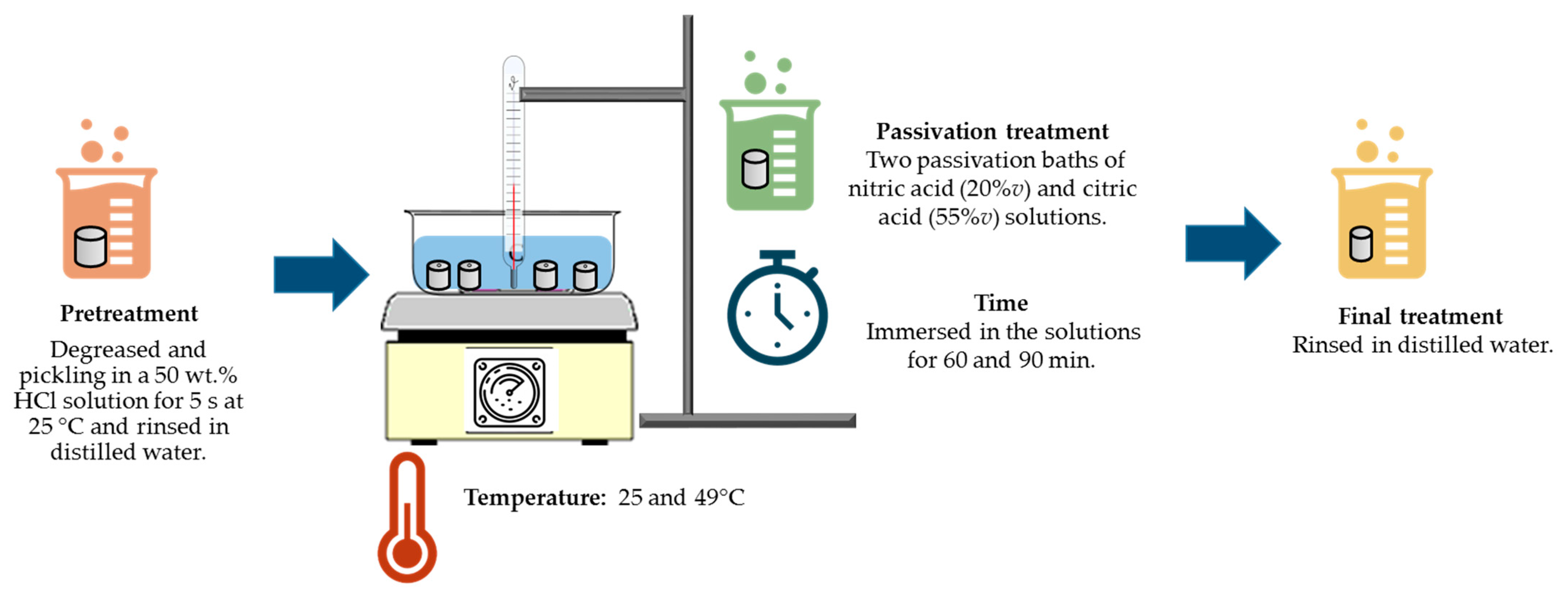
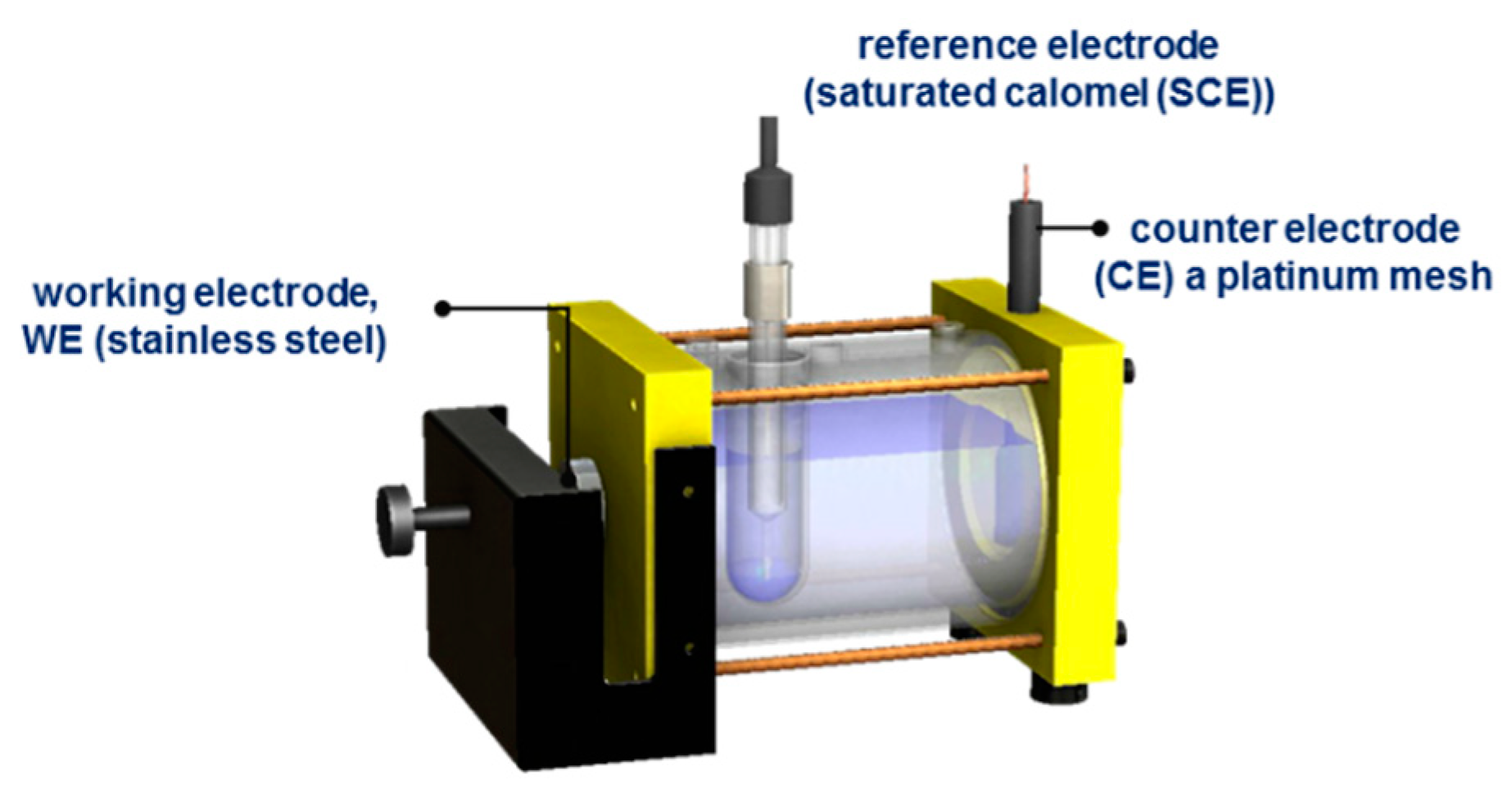
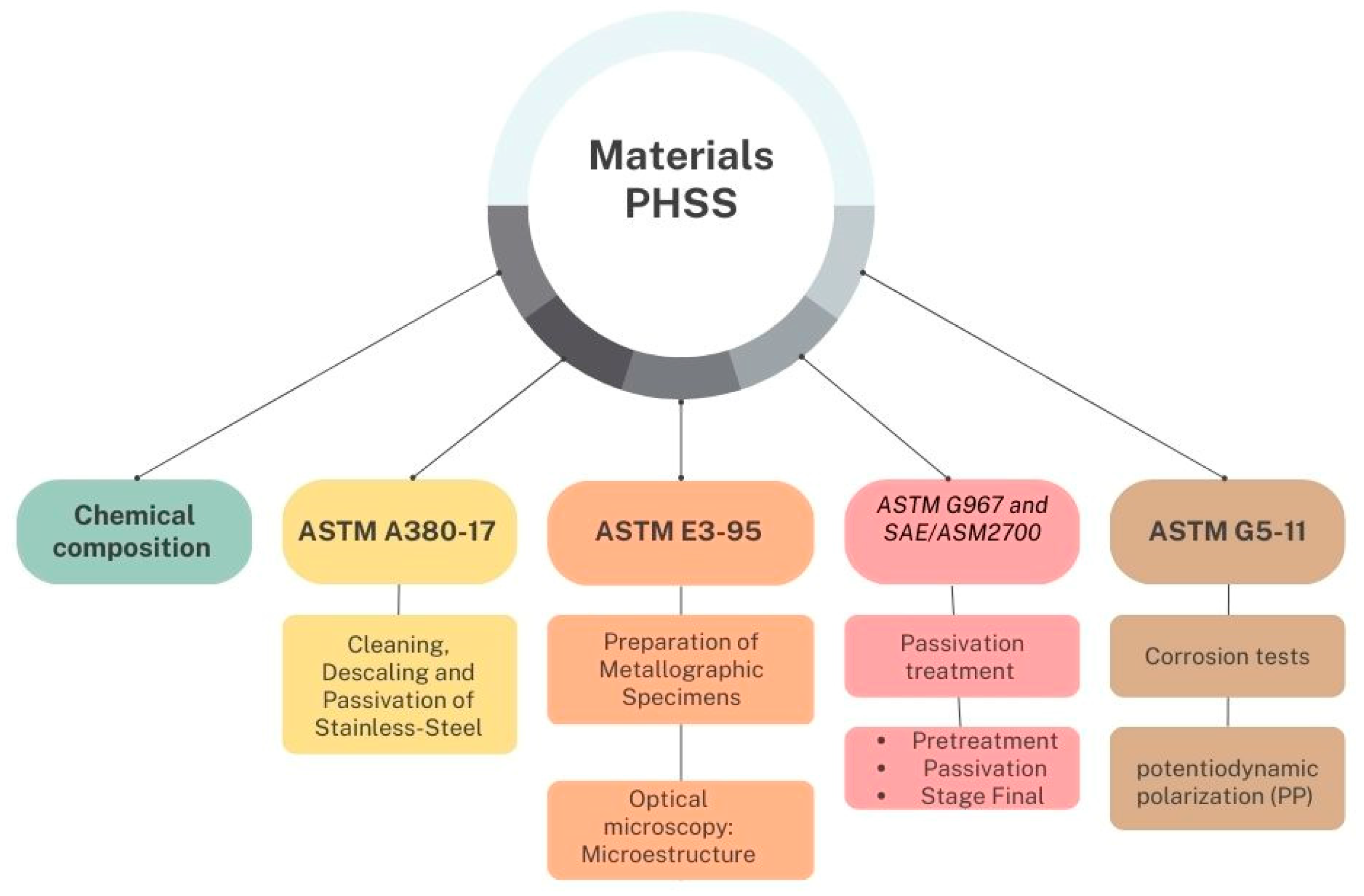
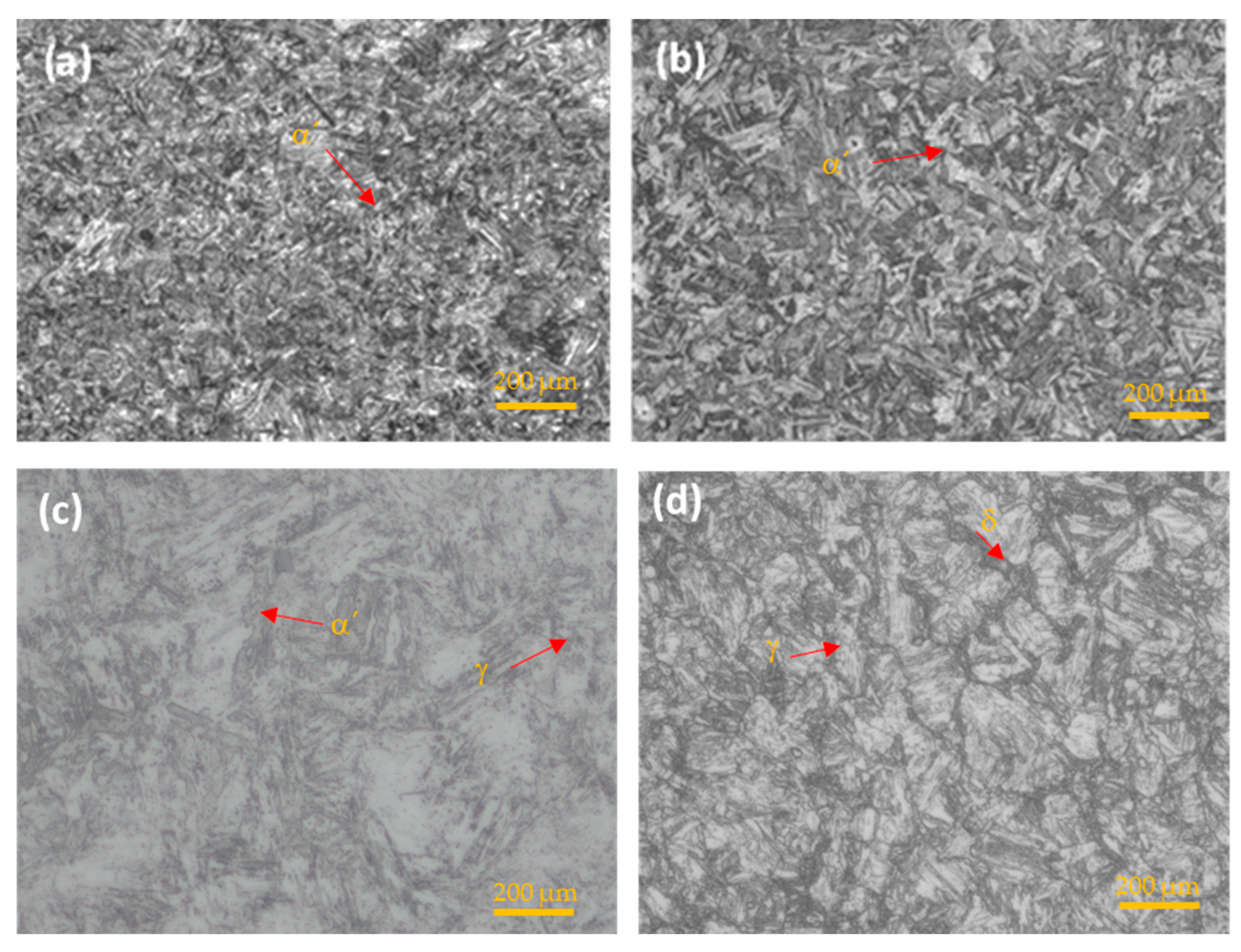
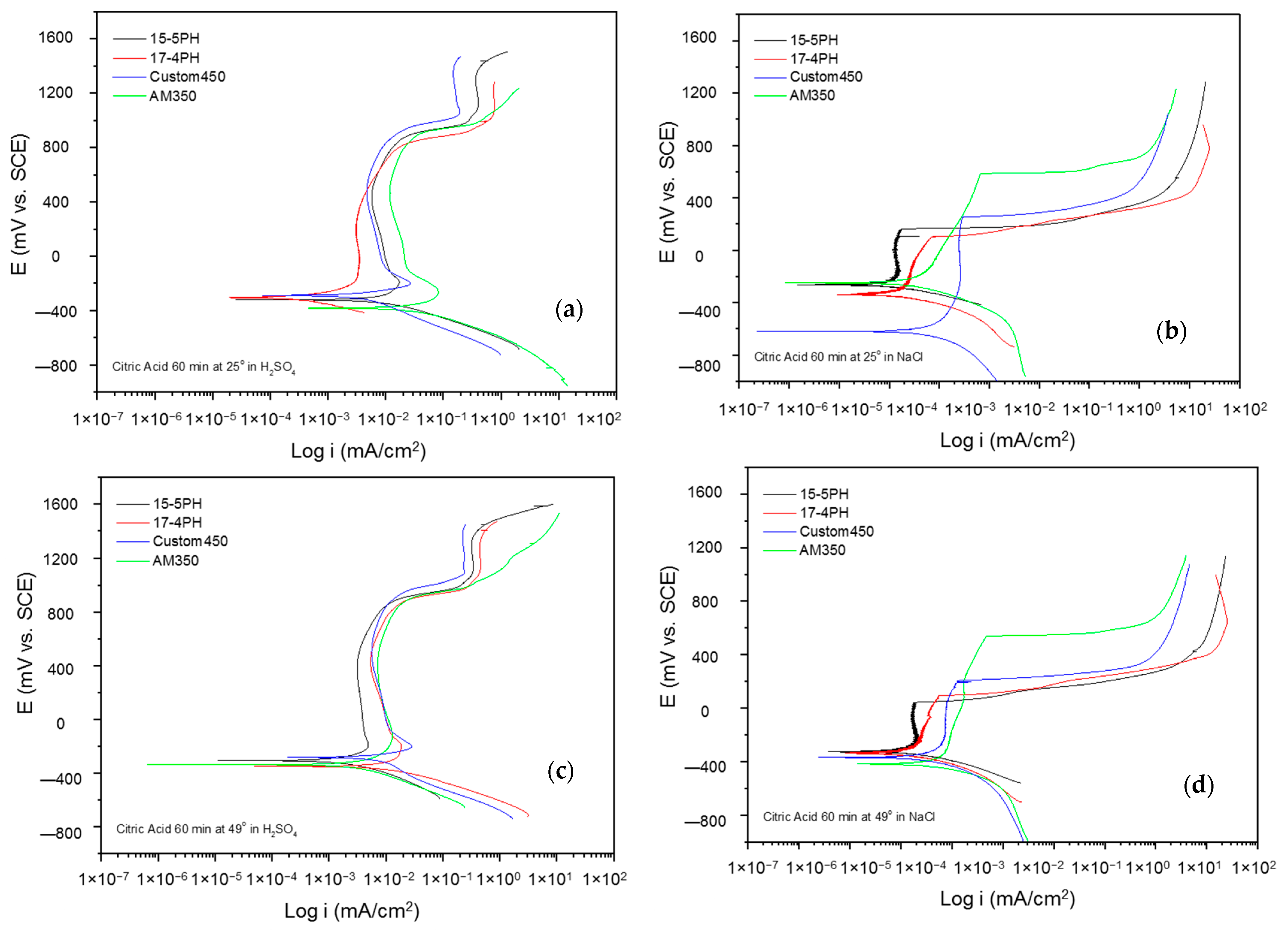


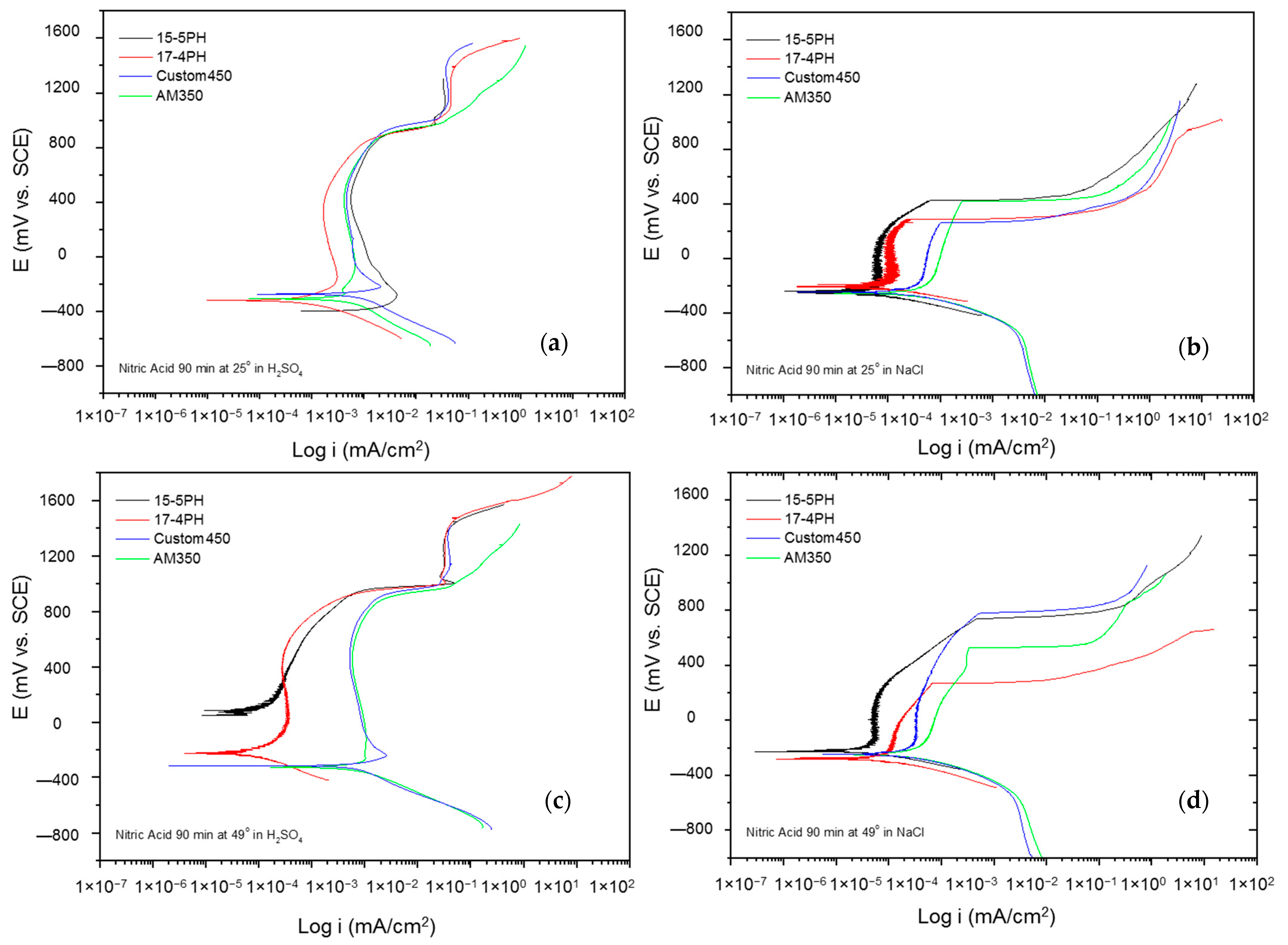
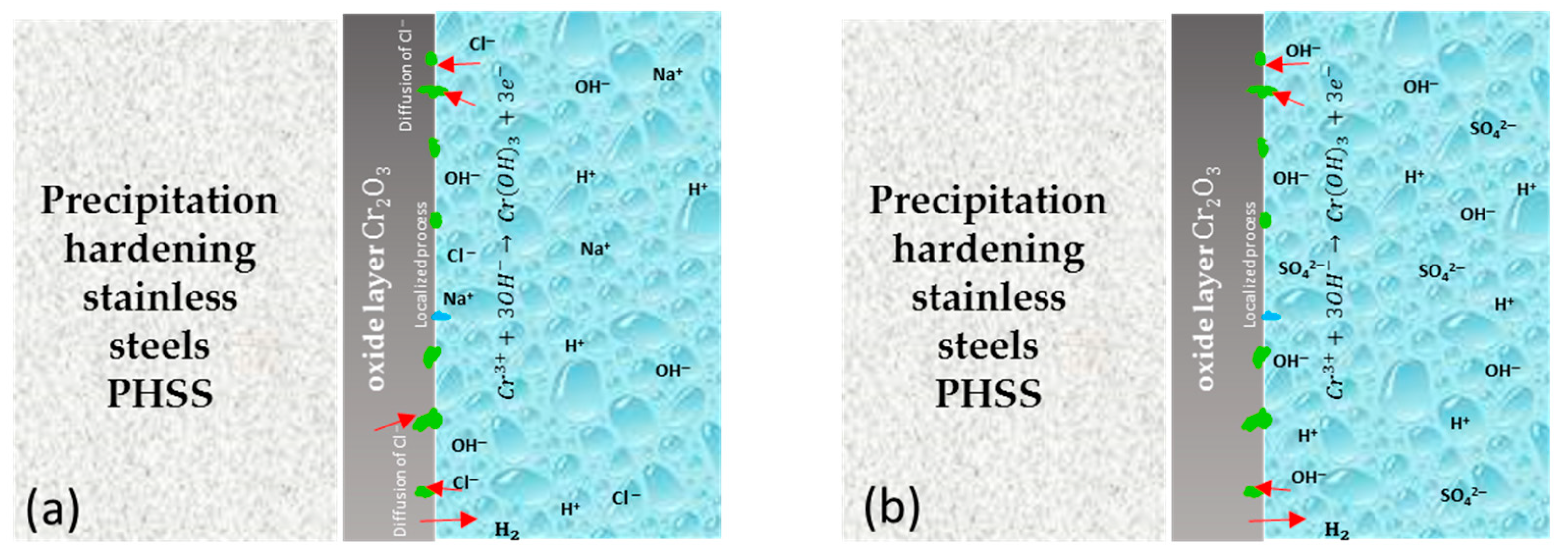
| PHSS | Elements | |||||||||||
|---|---|---|---|---|---|---|---|---|---|---|---|---|
| Cr | Ni | Mo | Mn | Cu | Ti | Nb | N | Si | S | C | Fe | |
| 15-5PH | 14.0–15.5 | 3.5–5.5 | – | 1.0 max. | 2.5–4.5 | – | 0.15–0.45 | – | 1.0 max. | 0.03 max. | 0.07 max | Balance |
| 17-4PH | 15.0–17.5 | 3.0–5.0 | 0.50 | 1.0 max. | 3.0–5.0 | – | 0.15–0.45 | – | – | 0.03 max. | 0.07 max. | Balance |
| Custom 450 | 14.0–16.0 | 5.0–7.0 | 0.50–1.0 | 1.00 | 1.25–1.75 | 0.90–1.40 | 0.5–0.75 | ≤0.1 | 1.00 | 0.030 | ≤0.05 | Balance |
| AM350 | 16.0–17.0 | 4.0–5.0 | 2.50–3.25 | 0.50–1.25 | – | – | – | 0.07–0.13 | ≤0.50 | 0.030 | 0.07–0.11 | Balance |
| PHSS | Cr | Mo | N | PREN |
|---|---|---|---|---|
| 15-5PH | 14.0–15.5 | – | 0.50 | 23.5 |
| 17-4PH | 15.0–17.5 | – | – | 17.5 |
| Custom 450 | 14.0–16.0 | 0.50–1.0 | ≤0.1 | 20.9 |
| AM350 | 16.0–17.0 | 2.50–3.25 | 0.07–0.13 | 29.80 |
| Solution | PHSS | Temp. (°C) | Ecorr (mV) | Epit (mV) | icorr (mA/cm2) | ipass (mA/cm2) | Range Passive (mV) | Corrosion Rate (mm/y) |
|---|---|---|---|---|---|---|---|---|
| H2SO4 | 15-5PH | 25 | −326 | 862 | 3.96 × 10−3 | 7.73 × 10−3 | 632 | 8.13 × 10−5 |
| 49 | −305 | 837 | 2.17 × 10−3 | 3.51 × 10−3 | 616 | 1.55 × 10−5 | ||
| 17-4PH | 25 | −332 | 789 | 1.44 × 10−3 | 3.18 × 10−3 | 394 | 3.93 × 10−6 | |
| 49 | −353 | 863 | 1.52 × 10−2 | 7.61 × 10−3 | 640 | 6.58 × 10−5 | ||
| Custom 450 | 25 | −312 | 768 | 9.52 × 10−3 | 5.64 × 10−3 | 722 | 8.68 × 10−3 | |
| 49 | −279 | 916 | 1.13 × 10−2 | 7.69 × 10−3 | 778 | 1.45 × 10−2 | ||
| AM350 | 25 | −247 | 586 | 4.64 × 10−4 | 1.53 × 10−2 | 737 | 1.06 × 10−2 | |
| 49 | −337 | 840 | 5.35 × 10−3 | 7.31 × 10−3 | 680 | 7.16 × 10−3 | ||
| NaCl | 15-5PH | 25 | −263 | 161 | 1.03 × 10−4 | 1.41 × 10−4 | 329 | 5.22 × 10−7 |
| 49 | −322 | 45 | 1.29 × 10−4 | 1.76 × 10−4 | 267 | 5.54 × 10−7 | ||
| 17-4PH | 25 | −340 | 105 | 1.63 × 10−4 | 2.37 × 10−4 * | 335 * | 7.91 × 10−7 | |
| 49 | −334 | 95 | 1.51 × 10−4 | 2.52 × 10−4 * | 338 * | 9.64 × 10−7 | ||
| Custom 450 | 25 | −619 | 251 | 8.29 × 10−4 | 2.59 × 10−3 | 518 | 7.57 × 10−4 | |
| 49 | −369 | 203 | 3.68 × 10−4 | 7.42 × 10−4 | 304 | 3.91 × 10−4 | ||
| AM350 | 25 | −249 | 586 | 2.96 × 10−4 | 6.83 × 10−4 * | 711 * | 8.52 × 10−5 | |
| 49 | −417 | 539 | 4.12 × 10−4 | 8.08 × 10−4 * | 849 * | 9.01 × 10−4 |
| Solution | PHSS | Temp. (°C) | Ecorr (mV) | Epit (mV) | icorr (mA/cm2) | ipass (mA/cm2) | Range Passive (mV) | Corrosion Rate (mm/y) |
|---|---|---|---|---|---|---|---|---|
| H2SO4 | 15-5PH | 25 | −329 | 831 | 1.30 × 10−3 | 3.17 × 10−3 | 731 | 3.67 × 10−6 |
| 49 | 46 | 601 | 3.87 × 10−5 | 1.34 × 10−4 | 657 | 1.01 × 10−6 | ||
| 17-4PH | 25 | −296 | 815 | 1.39 × 10−2 | 3.12 × 10−3 | 508 | 1.17 × 10−5 | |
| 49 | −352 | 819 | 2.85 × 10−3 | 3.09 × 10−4 | 530 | 4.47 × 10−7 | ||
| Custom 450 | 25 | −279 | 936 | 2.97 × 10−3 | 5.14 × 10−3 | 711 | 1.52 × 10−2 | |
| 49 | −241 | 937 | 5.36 × 10−3 | 1.47 × 10−3 | 878 | 6.41 × 10−3 | ||
| AM350 | 25 | −288 | 874 | 1.22 × 10−3 | 3.92 × 10−3 | 575 | 4.74 × 10−3 | |
| 49 | −360 | 882 | 4.78 × 10−3 | 1.43 × 10−2 | 994 | 5.11 × 10−2 | ||
| NaCl | 15-5PH | 25 | −291 | 116 | 4.53 × 10−5 | 6.42 × 10−5 | 212 | 3.63 × 10−7 |
| 49 | −239 | 425 | 4.34 × 10−5 | 6.16 × 10−5 | 251 | 2.28 × 10−7 | ||
| 17-4PH | 25 | −200 | 275 | 8.75 × 10−5 | 1.24 × 10−4 * | 394 * | 5.66 × 10−7 | |
| 49 | −275 | 400 | 6.43 × 10−5 | 7.93 × 10−5 | 214 | 3.67 × 10−7 | ||
| Custom 450 | 25 | −285 | 315 | 3.02 × 10−4 | 5.82 × 10−4 | 485 | 3.70 × 10−4 | |
| 49 | −223 | 536 | 1.86 × 10−4 | 3.46 × 10−4 * | 673 * | 2.58 × 10−4 | ||
| AM350 | 25 | −258 | 906 | 3.13 × 10−4 | 5.41 × 10−4 * | 1049 * | 3.09 × 10−4 | |
| 49 | −231 | 921 | 2.61 × 10−4 | 5.52 × 10−4 * | 1038 * | 3.71 × 10−4 |
| Solution | PHSS | Temp. (°C) | Ecorr (mV) | Epit (mV) | icorr (mA/cm2) | ipass (mA/cm2) | Range Passive (mV) | Corrosion Rate (mm/y) |
|---|---|---|---|---|---|---|---|---|
| H2SO4 | 15-5PH | 25 | −329 | 831 | 1.30 × 10−3 | 6.43 × 10−3 | 621 | 6.41 × 10−5 |
| 49 | 46 | 601 | 3.87 × 10−5 | 1.87 × 10−3 | 718 | 6.91 × 10−6 | ||
| 17-4PH | 25 | −296 | 815 | 1.39 × 10−2 | 7.27 × 10−3 | 761 | 1.12 × 10−4 | |
| 49 | −352 | 819 | 2.85 × 10−3 | 6.24 × 10−3 | 692 | 9.00 × 10−5 | ||
| Custom 450 | 25 | −279 | 936 | 2.97 × 10−3 | 7.42 × 10−3 | 722 | 1.31 × 10−2 | |
| 49 | −241 | 937 | 5.36 × 10−3 | 5.14 × 10−3 | 758 | 2.58 × 10−2 | ||
| AM350 | 25 | −288 | 874 | 1.22 × 10−3 | 7.34 × 10−3 | 698 | 2.46 × 10−2 | |
| 49 | −360 | 882 | 4.78 × 10−3 | 5.41 × 10−3 | 596 | 2.11 × 10−3 | ||
| NaCl | 15-5PH | 25 | −291 | 116 | 4.53 × 10−5 | 1.04 × 10−4 | 319 | 4.46 × 10−7 |
| 49 | −239 | 425 | 4.34 × 10−5 | 1.23 × 10−4 | 312 | 4.75 × 10−7 | ||
| 17-4PH | 25 | −200 | 275 | 8.75 × 10−5 | 2.52 × 10−4 * | 433 * | 9.12 × 10−7 | |
| 49 | −275 | 400 | 6.43 × 10−5 | 2.01 × 10−4 * | 355 * | 5.63 × 10−7 | ||
| Custom 450 | 25 | −285 | 315 | 3.02 × 10−4 | 9.81 × 10−4 * | 422 * | 6.26 × 10−4 | |
| 49 | −223 | 536 | 1.86 × 10−4 | 1.08 × 10−3 | 445 | 5.74 × 10−4 | ||
| AM350 | 25 | −258 | 906 | 3.13 × 10−4 | 8.09 × 10−4 * | 351 * | 6.95 × 10−4 | |
| 49 | −231 | 921 | 2.61 × 10−4 | 8.78 × 10−4 * | 1048 * | 8.95 × 10−4 |
| Solution | PHSS | Temp. (°C) | Ecorr (mV) | Epit (mV) | icorr (mA/cm2) | ipass (mA/cm2) | Range Passive (mV) | Corrosion Rate (mm/y) |
|---|---|---|---|---|---|---|---|---|
| H2SO4 | 15-5PH | 25 | −320 | 844 | 1.66 × 10−3 | 7.37 × 10−3 | 813 | 1.65 × 10−4 |
| 49 | 72 | 901 | 5.64 × 10−5 | 4.65 × 10−3 * | 752 * | 7.07 × 10−7 | ||
| 17-4PH | 25 | −418 | 860 | 2.11 × 10−2 | 1.92 × 10−3 | 715 | 5.19 × 10−6 | |
| 49 | −377 | 800 | 1.54 × 10−3 | 3.13 × 10−4 | 562 | 5.31 × 10−7 | ||
| Custom 450 | 25 | −305 | 934 | 3.91 × 10−3 | 5.48 × 10−3 | 883 | 1.65 × 10−2 | |
| 49 | −314 | 899 | 1.86 × 10−3 | 6.38 × 10−3 | 911 | 1.23 × 10−2 | ||
| AM350 | 25 | −307 | 895 | 1.29 × 10−3 | 4.93 × 10−3 | 735 | 1.24 × 102 | |
| 49 | −327 | 737 | 1.33 × 10−3 | 7.88 × 10−3 | 847 | 1.22 × 10−2 | ||
| NaCl | 15-5PH | 25 | −238 | 426 | 4.14 × 10−5 | 6.48 × 10−5 | 288 | 2.60 × 10−7 |
| 49 | −227 | 739 | 3.47 × 10−5 | 5.53 × 10−5 | 217 | 2.39 × 10−7 | ||
| 17-4PH | 25 | −206 | 285 | 8.33 × 10−5 | 1.14 × 10−4 | 259 | 5.10 × 10−7 | |
| 49 | −282 | 269 | 6.23 × 10−5 | 1.17 × 10−4 * | 452 * | 4.61 × 10−7 | ||
| Custom 450 | 25 | −247 | 260 | 2.27 × 10−4 | 4.43 × 10−4 * | 405 * | 4.01 × 10−4 | |
| 49 | −248 | 777 | 1.95 × 10−4 | 3.31 × 10−4 | 212 | 4.45 × 10−4 | ||
| AM350 | 25 | −257 | 417 | 3.38 × 10−4 | 7.22 × 10−4 * | 558 * | 3.89 × 10−4 | |
| 49 | −250 | 522 | 2.56 × 10−4 | 5.39 × 10−4 * | 671 * | 5.62 × 10−4 |
Disclaimer/Publisher’s Note: The statements, opinions and data contained in all publications are solely those of the individual author(s) and contributor(s) and not of MDPI and/or the editor(s). MDPI and/or the editor(s) disclaim responsibility for any injury to people or property resulting from any ideas, methods, instructions or products referred to in the content. |
© 2023 by the authors. Licensee MDPI, Basel, Switzerland. This article is an open access article distributed under the terms and conditions of the Creative Commons Attribution (CC BY) license (https://creativecommons.org/licenses/by/4.0/).
Share and Cite
Villegas-Tovar, J.; Gaona-Tiburcio, C.; Lara-Banda, M.; Maldonado-Bandala, E.; Baltazar-Zamora, M.A.; Cabral-Miramontes, J.; Nieves-Mendoza, D.; Olguin-Coca, J.; Estupiñan-Lopez, F.; Almeraya-Calderón, F. Electrochemical Corrosion Behavior of Passivated Precipitation Hardening Stainless Steels for Aerospace Applications. Metals 2023, 13, 835. https://doi.org/10.3390/met13050835
Villegas-Tovar J, Gaona-Tiburcio C, Lara-Banda M, Maldonado-Bandala E, Baltazar-Zamora MA, Cabral-Miramontes J, Nieves-Mendoza D, Olguin-Coca J, Estupiñan-Lopez F, Almeraya-Calderón F. Electrochemical Corrosion Behavior of Passivated Precipitation Hardening Stainless Steels for Aerospace Applications. Metals. 2023; 13(5):835. https://doi.org/10.3390/met13050835
Chicago/Turabian StyleVillegas-Tovar, José, Citlalli Gaona-Tiburcio, María Lara-Banda, Erick Maldonado-Bandala, Miguel Angel Baltazar-Zamora, Jose Cabral-Miramontes, Demetrio Nieves-Mendoza, Javier Olguin-Coca, Francisco Estupiñan-Lopez, and Facundo Almeraya-Calderón. 2023. "Electrochemical Corrosion Behavior of Passivated Precipitation Hardening Stainless Steels for Aerospace Applications" Metals 13, no. 5: 835. https://doi.org/10.3390/met13050835
APA StyleVillegas-Tovar, J., Gaona-Tiburcio, C., Lara-Banda, M., Maldonado-Bandala, E., Baltazar-Zamora, M. A., Cabral-Miramontes, J., Nieves-Mendoza, D., Olguin-Coca, J., Estupiñan-Lopez, F., & Almeraya-Calderón, F. (2023). Electrochemical Corrosion Behavior of Passivated Precipitation Hardening Stainless Steels for Aerospace Applications. Metals, 13(5), 835. https://doi.org/10.3390/met13050835








